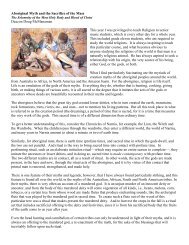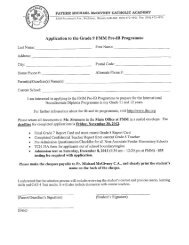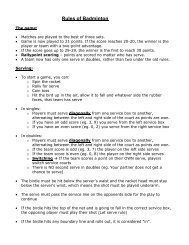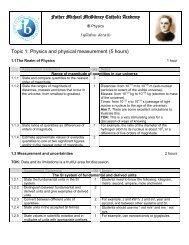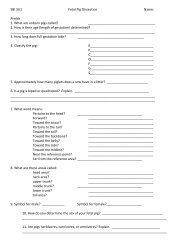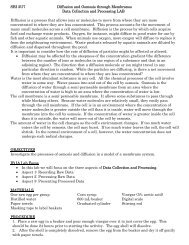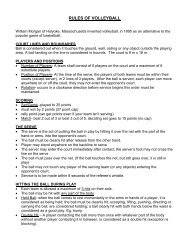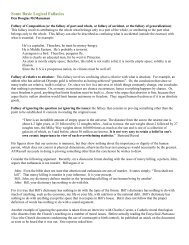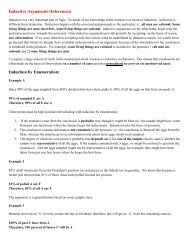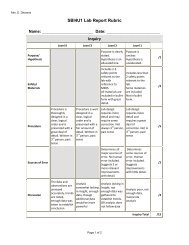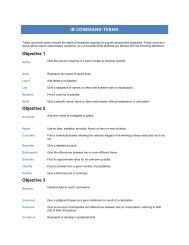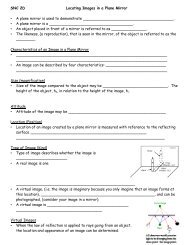Chemistry Review Manual 2
Chemistry Review Manual 2
Chemistry Review Manual 2
You also want an ePaper? Increase the reach of your titles
YUMPU automatically turns print PDFs into web optimized ePapers that Google loves.
(c) Since the amount of H 2 consumed equals the amount of H 2 O produced, 1.876 mol of H 2 O<br />
is produced.<br />
2 H 2 (g) + O 2 (g) → 2 H 2 O(l)<br />
Before 1.984 mol 0.938 mol 0 mol<br />
limiting reactant<br />
After 0.108 mol 0 1.876 mol<br />
We are asked for the mass of H 2 O produced. This is the theoretical yield, determined by<br />
calculation based on amount of limiting reagent used.<br />
1.4 Density<br />
mass of water = amount of water × Molar mass of water<br />
= × =<br />
−1<br />
1.876 mol 18.015 g mol 33.80 g<br />
Sometimes we are given the volume of a substance and not its mass. To determine the amount<br />
of the substance, we need to know the density of the substance. The density of a substance is<br />
the mass per unit volume. For example, the density of water under ordinary conditions is about<br />
1.00 g mL −1 . If we know the volume of a substance, then we can determine its mass from its<br />
density.<br />
mass = volume × density or m = V × d 1.2<br />
Example 1.5: The density of copper is 8.94 g mL −1 . What is the mass of a cube of copper<br />
1.00 cm × 1.00 cm × 1.00 cm ? Note that 1 mL = 1 cm 3 .<br />
Approach: Find cube volume. Use density and volume to solve for mass.<br />
First, we need the volume of the cube in mL<br />
1.00 cm × 1.00 cm × 1.00 cm = 1.00 cm 3 = 1.00 mL<br />
The mass of the copper cube is m = V x d,<br />
1.00 mL × 8.94 g mL -1 = 8.94 g<br />
Sometimes more elaborate unit conversions are required.<br />
Example 1.6: What is the mass of a cube of copper 1.00 m × 1.00 m × 1.00 m ?<br />
Again, we need the volume of the cube in mL. 3 This time, we will use the definition of the<br />
litre, 1 L = 1 dm 3 = 10 3 mL. [Note that 1 dm = 10 −2 m].<br />
V = (1.00 m) 3 = (10.0 dm) 3 = 10.0 3 dm 3 = 1.00 × 10 3 dm 3 = 1.00 × 10 3 L<br />
The mass of the copper cube is<br />
= 1.00 × 10 3 L × 10 3 mL/L = 10 6 mL<br />
10 6 mL × 8.94 g mL −1 = 8.94 × 10 6 g = 8.94 × 10 3 kg<br />
3 Alternatively, we could convert the density to units of g m −3 .<br />
Page 8 of 88



